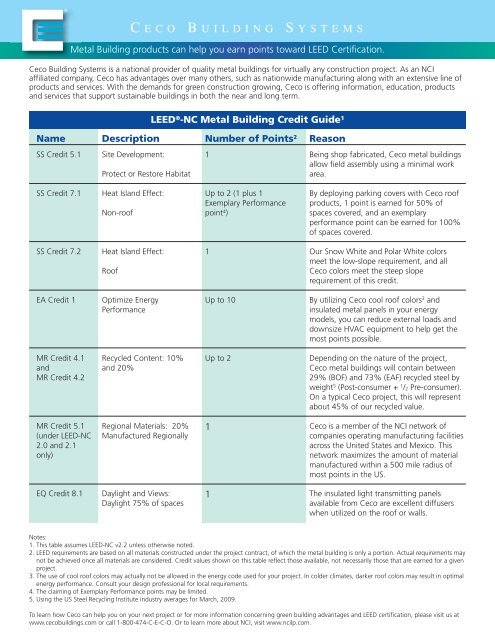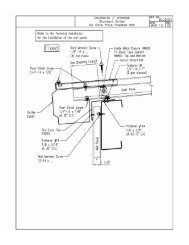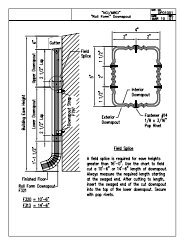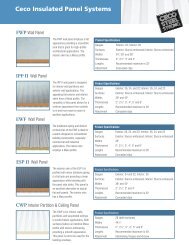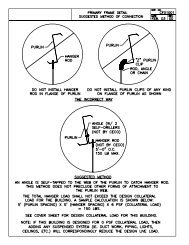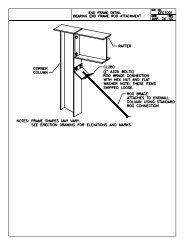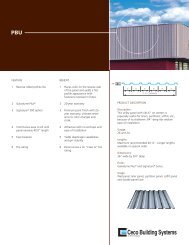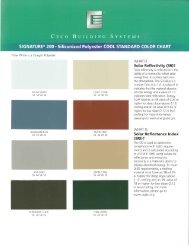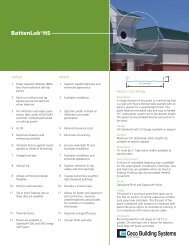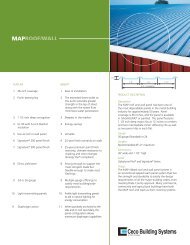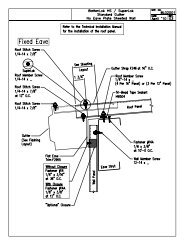The Cost of LEED Certification - Ceco Building Systems
The Cost of LEED Certification - Ceco Building Systems
The Cost of LEED Certification - Ceco Building Systems
Create successful ePaper yourself
Turn your PDF publications into a flip-book with our unique Google optimized e-Paper software.
C ECO B UILDING S YSTEMS<br />
Metal <strong>Building</strong> products can help you earn points toward <strong>LEED</strong> <strong>Certification</strong>.<br />
<strong>Ceco</strong> <strong>Building</strong> <strong>Systems</strong> is a national provider <strong>of</strong> quality metal buildings for virtually any construction project. As an NCI<br />
affiliated company, <strong>Ceco</strong> has advantages over many others, such as nationwide manufacturing along with an extensive line <strong>of</strong><br />
products and services. With the demands for green construction growing, <strong>Ceco</strong> is <strong>of</strong>fering information, education, products<br />
and services that support sustainable buildings in both the near and long term.<br />
<strong>LEED</strong> ® -NC Metal <strong>Building</strong> Credit Guide 1<br />
Name Description Number <strong>of</strong> Points 2 Reason<br />
SS Credit 5.1 Site Development:<br />
Protect or Restore Habitat<br />
SS Credit 7.1 Heat Island Effect:<br />
Non-ro<strong>of</strong><br />
SS Credit 7.2 Heat Island Effect:<br />
Ro<strong>of</strong><br />
EA Credit 1 Optimize Energy<br />
Performance<br />
MR Credit 4.1<br />
and<br />
MR Credit 4.2<br />
MR Credit 5.1<br />
(under <strong>LEED</strong>-NC<br />
2.0 and 2.1<br />
only)<br />
Recycled Content: 10%<br />
and 20%<br />
Regional Materials: 20%<br />
Manufactured Regionally<br />
EQ Credit 8.1 Daylight and Views:<br />
Daylight 75% <strong>of</strong> spaces<br />
1 Being shop fabricated, <strong>Ceco</strong> metal buildings<br />
allow field assembly using a minimal work<br />
area.<br />
Up to 2 (1 plus 1<br />
Exemplary Performance<br />
point 4 )<br />
By deploying parking covers with <strong>Ceco</strong> ro<strong>of</strong><br />
products, 1 point is earned for 50% <strong>of</strong><br />
spaces covered, and an exemplary<br />
performance point can be earned for 100%<br />
<strong>of</strong> spaces covered.<br />
1 Our Snow White and Polar White colors<br />
meet the low-slope requirement, and all<br />
<strong>Ceco</strong> colors meet the steep slope<br />
requirement <strong>of</strong> this credit.<br />
Up to 10 By utilizing <strong>Ceco</strong> cool ro<strong>of</strong> colors 3 and<br />
insulated metal panels in your energy<br />
models, you can reduce external loads and<br />
downsize HVAC equipment to help get the<br />
most points possible.<br />
Up to 2 Depending on the nature <strong>of</strong> the project,<br />
<strong>Ceco</strong> metal buildings will contain between<br />
29% (BOF) and 73% (EAF) recycled steel by<br />
weight 5 (Post-consumer + 1 /2 Pre-consumer).<br />
On a typical <strong>Ceco</strong> project, this will represent<br />
about 45% <strong>of</strong> our recycled value.<br />
1<br />
1<br />
<strong>Ceco</strong> is a member <strong>of</strong> the NCI network <strong>of</strong><br />
companies operating manufacturing facilities<br />
across the United States and Mexico. This<br />
network maximizes the amount <strong>of</strong> material<br />
manufactured within a 500 mile radius <strong>of</strong><br />
most points in the US.<br />
<strong>The</strong> insulated light transmitting panels<br />
available from <strong>Ceco</strong> are excellent diffusers<br />
when utilized on the ro<strong>of</strong> or walls.<br />
Notes:<br />
1. This table assumes <strong>LEED</strong>-NC v2.2 unless otherwise noted.<br />
2. <strong>LEED</strong> requirements are based on all materials constructed under the project contract, <strong>of</strong> which the metal building is only a portion. Actual requirements may<br />
not be achieved once all materials are considered. Credit values shown on this table reflect those available, not necessarily those that are earned for a given<br />
project.<br />
3. <strong>The</strong> use <strong>of</strong> cool ro<strong>of</strong> colors may actually not be allowed in the energy code used for your project. In colder climates, darker ro<strong>of</strong> colors may result in optimal<br />
energy performance. Consult your design pr<strong>of</strong>essional for local requirements.<br />
4. <strong>The</strong> claiming <strong>of</strong> Exemplary Performance points may be limited.<br />
5. Using the US Steel Recycling Institute industry averages for March, 2009.<br />
To learn how <strong>Ceco</strong> can help you on your next project or for more information concerning green building advantages and <strong>LEED</strong> certification, please visit us at<br />
www.cecobuildings.com or call 1-800-474-C-E-C-O. Or to learn more about NCI, visit www.ncilp.com.
C ECO B UILDING S YSTEMS<br />
<strong>The</strong> <strong>Cost</strong> <strong>of</strong> <strong>LEED</strong> <strong>Certification</strong><br />
What budget advice can estimators provide to their Clients for going green?<br />
By Joseph J. Perryman MRICS MAPM<br />
As more and more published articles appear that proudly state<br />
Projects have achieved <strong>LEED</strong> ® certification, whether they be in<br />
newspapers or magazines, more and more Clients are asking<br />
their Design Team or Contractor, “Can we afford <strong>LEED</strong> certification<br />
for our Project?” What is the correct advice to give Clients?<br />
In order to provide the advice, estimators must firstly understand<br />
the US Green <strong>Building</strong> Council’s Leadership in Energy and<br />
Environmental Design (<strong>LEED</strong>) standard. Four levels <strong>of</strong> certification<br />
exist – certified, silver, gold, and platinum. Each level is reached<br />
by obtaining points from a <strong>LEED</strong> rating system that <strong>of</strong>fers 7<br />
prerequisite points and 69 elective points. To achieve any<br />
certification a Project must comply with the 7 prerequisite points.<br />
<strong>The</strong> elective points are what determine the <strong>LEED</strong> rating level with<br />
Certified requiring between 40 and 49 points, Silver requiring<br />
between 50 and 59 points, Gold requiring between 60 and 79<br />
points, and Platinum, the highest level, requiring 80 points<br />
and above.<br />
<strong>The</strong> key for estimators therefore is to (a) ascertain whether a<br />
particular point is achievable for their particular Project, and (b)<br />
evaluate what each valid point will cost. In order to ascertain<br />
whether a particular point is achievable, the estimator should<br />
join members <strong>of</strong> the Design Team in participating in a workshop<br />
to identify the potential for incorporation <strong>of</strong> each <strong>of</strong> the 69<br />
points. This workshop should happen at the earliest opportunity<br />
in the design phase as this will allow suitable time for a smooth<br />
transition <strong>of</strong> the selected points into the Project’s design. A<br />
significant amount <strong>of</strong> points are awarded for the designing <strong>of</strong><br />
mechanical and plumbing systems therefore the mechanical<br />
engineer should play a pivotal role at the workshop.<br />
Following the identification <strong>of</strong> the available points, the estimator<br />
can begin to evaluate the cost implications <strong>of</strong> incorporating each<br />
particular point. It is important to remember that the costs may<br />
either be pure additional costs, premium costs or may even have<br />
no cost implications. For example: incorporating bicycle racks<br />
and showers would be a pure additional cost, using certified<br />
wood in lieu <strong>of</strong> non-certified wood may be a premium cost, and<br />
proximity to mass transit will have no cost implications as this<br />
relates purely to the location <strong>of</strong> the Project site (unless <strong>of</strong> course<br />
the Project has options with regards to site location.)<br />
<strong>The</strong> author has also found it to be the case that certain<br />
points are realized at no additional cost due to the high level<br />
construction performance that today’s contractors insist upon<br />
as standard practice. Clearly, the higher the certification level,<br />
the more it is required to accept the points that have significant<br />
additional cost impact. <strong>The</strong> strategy therefore is to firstly seek the<br />
points that have no financial impact, followed by either the<br />
insignificant premium costs or the insignificant additional<br />
costs. <strong>The</strong> expensive points are usually only sought when<br />
applying for Gold or Platinum certification. It is the author’s<br />
experience that, with an early instruction from the Client to<br />
seek certification, certified and silver can be achieved at<br />
minimal cost however gold and platinum will typically have<br />
a significant cost implication.<br />
Estimators should not forget about the administration costs<br />
associated with achieving <strong>LEED</strong> certification. Every point<br />
will be monitored during design and construction to ensure<br />
it is implemented into the building. Depending upon the<br />
contractual relationships that exist, the responsibility for<br />
incorporating <strong>LEED</strong> can lie with the Design Team, the<br />
Construction Manager, or the Client. Regardless <strong>of</strong> where<br />
the responsibility lies, the costs involved with writing<br />
Specifications, identifying costs within subcontractor bids,<br />
filing and management <strong>of</strong> necessary documentation for final<br />
application to the USGBC etc. will all have a cost impact.<br />
Grants exist for Clients who seek <strong>LEED</strong> certification. <strong>The</strong><br />
potential amount receivable may not be known at the early<br />
stages <strong>of</strong> a Project but these additional funds should not<br />
be forgotten about during presentation <strong>of</strong> the overall<br />
financial implication <strong>of</strong> seeking <strong>LEED</strong> certification.<br />
To conclude, the cost <strong>of</strong> <strong>LEED</strong> certification depends upon:<br />
the level <strong>of</strong> certification sought, the particular Project<br />
demographics and characteristics, the availability <strong>of</strong> grants<br />
for achieving certification, the <strong>LEED</strong> experience <strong>of</strong> the Design<br />
Team, the <strong>LEED</strong> experience <strong>of</strong> the estimator, the stage<br />
in the design at which the Client makes the decision to<br />
seek certification (the earlier the better), and the Client’s<br />
perception <strong>of</strong> the value and benefits <strong>of</strong> a more attractive<br />
building environment for their occupants. Whilst the<br />
factors above may seem numerous, they are quantifiable,<br />
they can be priced, and they can be managed.<br />
Joseph Perryman is both a cost consultant and owner’s<br />
representative for a firm that specializes in project and cost<br />
management <strong>of</strong> performing arts and museum facilities.<br />
Joseph is also a member <strong>of</strong> the Association for Project<br />
Management, the USGBC, the Royal Institution <strong>of</strong><br />
Chartered Surveyors, SAVE International, American Society<br />
<strong>of</strong> Pr<strong>of</strong>essional Estimators and is Chairman <strong>of</strong> the ASPE<br />
<strong>LEED</strong>/Sustainability Specific Interest Group. Contact Joseph<br />
at joseph@dcicost.com<br />
© 2009 Copyright DC&D Technologies, Inc. All rights reserved.<br />
Design <strong>Cost</strong> Data Magazine<br />
Used with permission<br />
To learn how <strong>Ceco</strong> can help you on your next project or for more information concerning green building advantages and <strong>LEED</strong> certification, please visit<br />
us at www.cecobuildings.com or call 1-800-474-C-E-C-O. Or to learn more about NCI, visit www.ncilp.com.


